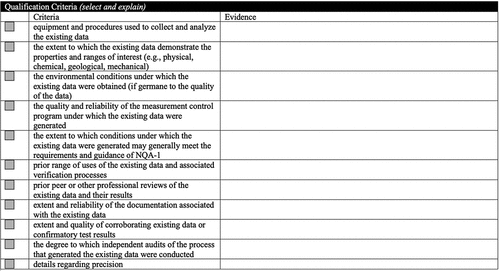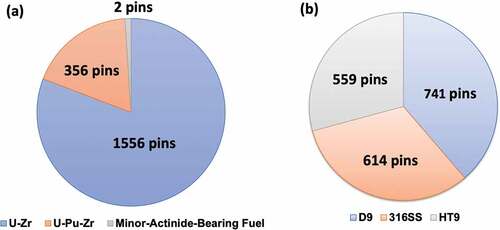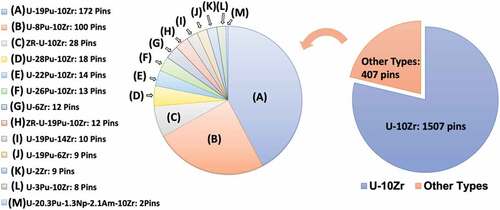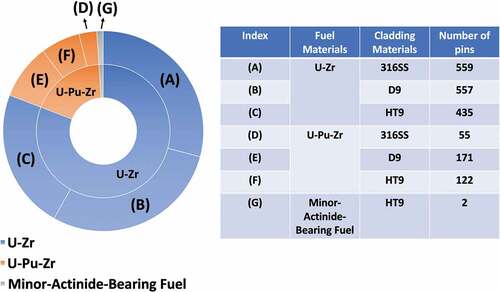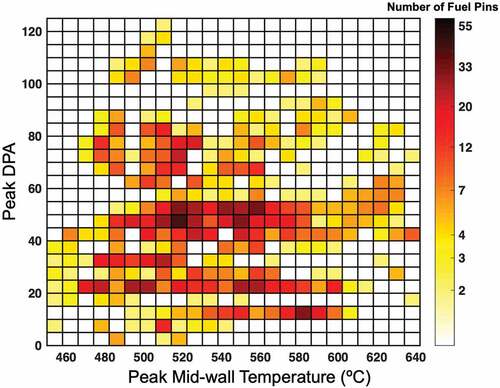 ?Mathematical formulae have been encoded as MathML and are displayed in this HTML version using MathJax in order to improve their display. Uncheck the box to turn MathJax off. This feature requires Javascript. Click on a formula to zoom.
?Mathematical formulae have been encoded as MathML and are displayed in this HTML version using MathJax in order to improve their display. Uncheck the box to turn MathJax off. This feature requires Javascript. Click on a formula to zoom.Abstract
Metallic fuel is proposed for use in various advanced sodium-cooled fast reactor (SFR) designs, including small modular reactors and microreactors. To support advanced SFR research and development, a metallic fuel database has been developed at Argonne National Laboratory. The database was built on extensive metallic fuel data collected during the Integral Fast Reactor Program, mainly from irradiation experiments in the Experimental Breeder Reactor-II (EBR-II). In order to manage the large amount of data and associated documents and to qualify the data, a Quality Assurance Program Plan (QAPP) was established for the legacy metallic fuel data following the American Society of Mechanical Engineers (ASME) Nuclear Quality Assurance (NQA-1) 2008/2009 Addenda Standard. Metallic fuel data qualification is being performed following the QAPP. The plan has been approved by the U.S. Nuclear Regulatory Commission and can be referenced in licensing applications for nuclear power plants. The process for qualifying metallic fuel data is presented. The structure for implementing the QAPP and the qualification methods are introduced. The principle for prioritizing the metallic fuel data for quality assurance is summarized. An overview of the metallic fuel data available and considered for qualification is also provided.
I. INTRODUCTION
Uranium-zirconium (U-Zr)– and uranium-plutonium-zirconium (U-Pu-Zr)–based metallic fuels have been considered to be advantageous fuel materials for sodium-cooled fast reactor (SFR) applications, especially when compared to oxide fuel. These advantages include high thermal conductivity, fuel-coolant compatibility, high density, improved uranium utilization, safety, and straightforward reprocessing.Citation1 Oklo Power recently adopted U-Zr fuel Citation2,Citation3 to develop its fast neutron spectrum microreactor, Aurora, and a custom combined license for the Aurora reactor has been submitted to the U.S. Nuclear Regulatory CommissionCitation4 (NRC). The utilization of high-density and high-thermal conductivity U-Zr-based metallic fuel in sodium-cooled fast microreactors is consistent with the functional and operational requirements of these reactors, including compact core and potential long-life operations. This fuel material is also utilized in the design and development of other scales of advanced SFRs in the United States, including TerraPower’s NATRIUM™ reactorCitation5 and ARC Clean Energy’s ARC-100 small modular reactorsCitation6 (SMRs).
The licensing of these reactors will require comprehensive knowledge of fuel performance at fast neutron spectrum conditions at various burnups and temperatures in a sodium coolant environment. Fortunately, U-Zr/U-Pu-Zr metallic fuels were studied extensively in the Experimental Breeder Reactor-II (EBR-II) (CitationRef. 7) and the Fast Flux Test FacilityCitation8 (FFTF), in particular during the period between 1984 and 1994 when extensive metallic alloy fuel data were generated during the Integral Fast Reactor (IFR) program.Citation9,Citation10 Recovery of this metallic fuel knowledgebase is being performed at Argonne National Laboratory (ANL) by developing and maintaining a database, the Fuels Irradiation & Physics DatabaseCitation11,Citation12 (FIPD). The FIPD is an organized collection of mostly EBR-II test pin–related data and documentation that correspond to a variety of experiments with different goals and objectives aimed at demonstrating the qualification of the fuel to be used in SFRs under different operating conditions. The fuel data include three major components: (1) fuel pin operation conditions calculated using a collection of ANL’s analysis codes developed during the IFR program, (2) fuel pin–measured data from post-irradiation examination (PIE), and (3) fuel pin as-built fabrication data.Citation11,Citation12
Data management of the extensive data archived in the FIPD is challenging in relation to retaining data integrity and availability. Qualification work of these legacy metallic fuel data is supported by the U.S. Department of Energy’s (DOE’s) Office of Nuclear Energy (NE). The effort aims to evaluate the quality of the data generated during the IFR program and to support the use of the qualified data for the licensing of advanced reactor designs based on metallic fuel. Other applications of the qualified data include their use in supporting modeling and simulation activities and fuel performance code development, as well as other end users, including other DOE programs [e.g., the Versatile Test Reactor (VTR)] and educational institutions. This paper introduces the qualification program plan that follows the American Society of Mechanical Engineers (ASME) Standard National Quality Assurance (NQA-1) 2008/2009 AddendaCitation13 requirements for the qualification of legacy data and the method adopted in the metallic fuel data qualification. A summary of the metallic fuel data covered under the qualification plan is provided in this work so that readers and database users can better understand the extent of the available metallic fuel data that are being qualified for use by industry and other stakeholders.
II. QUALITY ASSURANCE PROGRAM
Over the past few years, ANL has collected, maintained, and qualified metallic fuel data generated throughout the U.S. SFR program. The bulk of the data was generated during the IFR program, from the EBR-II, FFTF, and TREAT reactors. The DOE and national laboratory teams believe that these legacy metallic fuel irradiation and transient testing databases provide quality information to assure sufficient tolerance with a large margin to failure within the operating envelope of typical SFR designs. The database development efforts have emphasized the preservation of historical information and its organization in electronic format for online access. Currently, priorities are focused on information management and establishing the quality of the existing data. The ASME NQA-1 2008/2009 Addenda provides appropriate requirements to assess data integrity, completeness, and availability. Accordingly, ANL has established a Quality Assurance Program Plan (QAPP) for the legacy metallic fuel data in the FIPD using the ASME NQA-1 2008/2009 Addenda standard.Citation14 The following is a description of the QAPP, the qualification method that is currently applied to the data, and the Software Qualification Program Plan (SQAPP) associated with the data.
II.A. Quality Assurance Program Plan
The QAPP is the top-level policy document that establishes the way in which quality is confirmed for the SFR legacy metallic fuel data. Implementing documents prescribe more detailed responsibilities and requirements and define the organizational interfaces involved within the scope of the QAPP. The Quality Assurance and Vendor Inspection Branch in the NRC has completed its review and determined that ANL QAPP satisfies the quality assurance (QA) requirements of Appendix B to Title 10 of the Code of Federal Regulations (10 CFR) Part 50 (CitationRef. 14). This was followed by an NRC audit of the QAPP implementation, which concluded that the QAPP as implemented provides sufficient quality program controls on key legacy data that are to be used by applicants.Citation15
The implementation of the QAPP is essential to ensure the quality of data in the FIPD, guiding the ongoing FIPD development. The data qualification process described in the QAPP includes the following qualification methods:
QA program equivalency: Determine if the acquisition, processing, and archiving of data have been performed in accordance with sound technical, administrative practices in compliance with NRC requirements and guidance.
Peer review: Independent evaluation of data to determine if the originally employed QA methodology is acceptable and confidence is warranted in the data acquisition.
Data corroboration: Determine if subject matter data comparisons can be shown to substantiate or confirm parameter values.
Note that the list of qualification methods does not include “confirmatory testing,” which is also included in the possible qualification methods recommended in the ASME NQA-1 2008 standard.Citation16 The exclusion of confirmatory testing was based on the NRC review of the QAPP (CitationRef. 14).
II.B. Peer Review Method
An initial effort to consider these different methods of qualification led to the conclusion that the peer review method is the appropriate method for such legacy data qualification efforts based on available records associated with the legacy metallic fuel data.Citation17 For example, the program equivalency method required the availability of detailed information on instrument calibration and training of staff performing PIE measurements, which were unavailable at the time when this method was considered for qualification (the relevant records were not maintained). More details on the program equivalency evaluation that have led to the decision to perform the current metallic fuel data qualification using the peer review method are provided in Sec. III.
The peer review method is used to independently evaluate data to determine if the employed methodology was acceptable, confidence is warranted in the data acquisition or developmental results, or if the data have been used in a similar range of applications.Citation16 One or more subject matter experts (SMEs) with expertise in the area of fuels and materials are assigned to perform the data evaluation based on the requirements described in the NQA-1 standards and to conclude whether the data are acceptable. The SMEs perform the following:
Evaluate data acquisition to determine the acceptability of the uncertainties associated with the employed data acquisition.
Evaluate the adequacy and appropriateness of the interpretations derived from the data and the extent to which the uncertainties affect the interpretations, conclusions, and overall validity of the data.
Reach a conclusion on the data quality based on the uncertainties and/or the appropriateness of the data interpretations made and fully documented.
Prepare a report documenting the established peer review activity.
A procedure based on the QAPP that was established for the peer review process is described in more detail in Sec. III.
II.C. Software Quality Assurance Plan
During the IFR program, a series of physics and thermal-hydraulic codes were used to compute the operating conditions of the test pins. The neutronic codes include the RCTP, RCT (CitationRef. 18), DIF3D (CitationRefs. 19 and Citation20), REBUS-3 (CitationRefs. 18 and Citation21), and MCCitation2-2. The thermal-hydraulic codes include EBRFLOW (CitationRef. 22) and SUPERENERGY-II (CitationRefs. 23 and Citation24). Detailed functions of the codes and the calculated operating parameters are shown in . The calculated conditions are stored in the FIPD. More details on the operating parameters are given in Sec. IV. To qualify the software associated with the database, a separate QA plan has been developed, the Nuclear Fuel Codes and Data SQAPP (CitationRef. 25). The relationship between the QAPP and SQAPP for metallic fuel data qualification can be seen in . More details about the SQAPP can be found in CitationRef. 11. An initial assessment of the operating parameter qualification activities is provided in CitationRef. 26.
TABLE I ANL Physics and Thermal-Hydraulic Codes Used to Calculate Pin Operating Conditions
III. QAPP IMPLEMENTATION
Although the QA program aims mainly to support industry efforts for licensing advanced SFR designs that utilize metallic fuels, it is important to emphasize the data qualification effort needed for other end users of the databases. shows other potential end users of the database, including DOE programs such as the Nuclear Energy Advanced Modeling and Simulation (NEAMS) program and the VTR, as well as universities. As shown in the figure (in frame with red background), the main interest of these users will be the PIE data, the calculated operational parameters, and the as-built fabrication data. These data are typically needed for code validation activities or model developments in support of their programmatic and educational needs. Meanwhile, industry users require more detailed documentation that supports their licensing efforts and their communications with the licensing agencies. For example, documents including the QA procedure forms of the qualified data, QA procedures at the hot cells where the measurements were taken [Hot Fuel Examination Facility and Alpha-Gamma Hot Cell Facility (AGHCF)], and the details of how the measurements were taken at the time [included in specifications of PIE data (see Sec. III.C)] and staff training will be of interest to industry stakeholders but will not necessarily be needed for NEAMS code validation efforts. The following subsections provide more details regarding the qualification process.
III.A. Determination of Appropriate Qualification Method
The first step of the qualification process was to determine the appropriate qualification method. As mentioned earlier, there are typically three qualification methods available based on NQA-1 guidelines (not including confirmatory testing per the NRC review of the QAPP): QA program equivalency, peer review, and data corroboration. The data corroboration option was not possible to consider at the time of the initial evaluations since the metallic fuel data sets considered for qualification are unique and there have been no comparable sets of data generated under other programs in the United States or abroad. Next, the QA program equivalency option was considered for the evaluation. CitationReference 17 provides details of the evaluation, where the acceptability of the data was assessed by the QA program equivalency method using applicable NQA-1 criteria including
Organization
Test Planning, Implementation, and Documentation (Research Planning)
Equipment Calibration and Documentation
Procurement Document Control
Training and Personnel Qualification
Analysis/Modeling Software Verification and Validation
Records
Data Acquisition/Collection and Analysis
Control of Special Processes
Quality Assurance.
The QA program equivalency of the data was tested using a subset of PIE data of pin T314 irradiated in the IFR X419 experiment; specifically, the fuel density measurement data were evaluated. Since the measurements were taken at the AGHCF facility, the evaluation process considered the facility QA program plan at the time of measurements, measurement procedures, original experiment data book documents associated with the pin PIE, and the paper trail of AGHCF measurements performed on the fuel element with notes on the dates of the different measurements, as well as the element-sectioning diagrams. Based on the evaluation, the following conclusion was made:
While the assertion of NQA-1 compliance is identified in the plan, the documentation of instrument calibration, training and qualification, QA records and document control itself are not in evidence. As such, while there is reasonable evidence that the intent of NQA-1 was in place at the time that the density data were generated; there is insignificant documentation to so demonstrate.
Since the density measurement was one of the simplest PIE measurements, it was evident based on this exercise that the QA program equivalency qualification method could not be applied to the rest of the data.
III.B. Qualification Process Details: Peer Review Method
Dismissal of the QA program equivalency approach led to an assessment based on a peer review process. As mentioned earlier, the peer review method is an independent evaluation of data to determine if the originally employed QA methodology is acceptable and confidence is warranted in the data acquisition. In this case, the evaluation process starts with one or more SMEs designated by the fuel development and qualification manager (the manager responsible for the data at ANL) to evaluate data through several tasks described in Sec. II.B. A procedure based on the QAPP was developed to provide a formal systematic assessment of the data by the SMEs that includes
Data identification, data traceability (origin, measurement date, current storage location, etc.), data description
General issues with the data
Previously applied quality programs, procedures, and documentation
Evaluation measures
Qualification criteria
Results of the evaluation.
A key component of the evaluation form is the qualification criteria, which are listed in .
The SME evaluation of each type of data or groups of data using this evaluation form is the key step of the data qualification process using the peer review method. Complementing a thorough evaluation by the SME is a package of QA documents, procedures, experiment safety package, data books, cutting diagrams, meeting notes, etc., that support the evaluation process and can ultimately be made available to the stakeholder interested in the qualified data.
III.C. Specifications of PIE Data
In addition to filling the peer review form for the different data sets as part of the qualification process, a new set of documents, PIE data specifications, was established to complement the SME activities. A specification document for each type of PIE measurement summarizes the principles of interpreting the data and provides other relevant information to understand how the measurement data were collected. A typical example is shown in for the contact profilometry data (cladding diameter measurement). The raw data preserved in the database are the profilometry traces without many details about the measurement (scales for x-axis, y-axis, scan direction, uncertainties, etc.) as shown in . These details were collected from other legacy documents and summarized in a new document, Specification of Contact Profilometry Data. The procedure that shows how to establish the location of the bottom of the fuel slug is provided in this specification document. The procedure steps, shown in , are as follows:
Fig. 3. (a) Raw contact profilometry data in the FIPD and (b) the interpretation of the bottom of fuel slug in the contact profilometry data sheet.
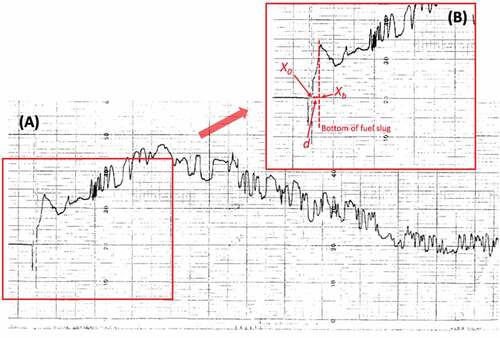
[F]irst, identify the sudden blip near the start of the trace, X0 (the sudden large blip was induced by the rollers hitting the reduced area in the lower end plug, and often a smaller one where the tube-to-plug weld area was traversed; second, find out the distance (either from neutron radiography (NRAD) or detailed drawing of fuel pin) between the weld area and the top of the end plug (which is the bottom of fuel slug), d; and third, add such distance to X0 to deduce the bottom of fuel slug: . (CitationRef. 29)
Without guidance from a specification document, users of the data will not be able to trace how the data were collected and how to appropriately interpret them. Industry users have shown strong interest in the specification documents and their association with the qualified data in support of their licensing efforts.
IV. DATA QUALIFICATIONS
IV.A. Overview of Metallic Fuel Data Under Qualification
As mentioned previously, the metallic fuel data currently available in the FIPD are either pending QA review or have already been reviewed. Given the amount of data in the FIPD, priorities are set for QA reviews according to stakeholders’ needs, which are based on their prospective fuel designs and specifications. The parameters for prioritizing the data for QA can include
Fuel type: binary (U-Zr) or ternary (U-Pu-Zr); specific compositions
Types of cladding: D9, HT9, or SS316
Estimated range of fuel burnup
Estimated range of fuel temperature
Estimated range of power density.
For example, Oklo Power’s Aurora reactor adopted U-10Zr fuel clad with SS316. The estimated fuel temperature is ~650°C and the target burnup is ~1% (CitationRef. 2). On the other hand, the VTR program plans to employ U-20Pu-10Zr clad with HT9 as the driver fuel.Citation30 The metallic fuel data to be qualified were prioritized following such specifications.
IV.B. Fuel and Cladding Materials
The FIPD currently contains the data and relevant documentations of ~1900 metallic fuel pins that were irradiated in the EBR-II. These fuel pins cover various fuel and cladding materials with a wide range of operating conditions, such as temperatures, burnups, power densities, etc. Two major categories of fuel studied during the IFR program were binary (U-Zr) and ternary (U-Pu-Zr) fuels. shows the distribution of available fuel materials in the FIPD: 1556U-Zr fuel pins and 356U-Pu-Zr fuel pins, with two minor-actinide-bearing (U-20.3Pu-1.3Np-2.1Am-10Zr) fuel pins. A more detailed breakdown of fuel pin composition can be seen in . The majority of the data is for U-10Zr fuel, which was the qualified metallic fuel material of multiple EBR-II driver fuel designs, including Mark-IIC, Mark-IICS, Mark-III, Mark-IIIA, and Mark-IV (CitationRef. 31). In addition to U-10Zr data, a wide range of U-Pu-Zr data are available covering the Pu range from 3 to 28 wt%, including (1) U-3Pu-10Zr, (2) U-8Pu-10Zr, (3) U-19Pu-6Zr, (4) U-19Pu-10Zr, (5) U-19Pu-14Zr, (6) U-22Pu-10Zr, (7) U-26Pu-10Zr, and (8) U-28Pu-10Zr. The Zr-U-10Zr and Zr-U-19Pu-10Zr refer to Zr-sheathed fuels that have an average composition of U-10Zr and U-19Pu-10Zr, respectively. The Zr-sheathed fuels were developed and irradiated in experiment X492 to examine potential fuel-cladding chemical interaction resistance by applying a Zr sheath to the fuels to compare to regular unsheathed fuel.Citation32
Compared to the diverse range of fuel materials, the fuel pins in the FIPD cover three cladding materials: SS316, D9, and HT9, the cladding materials for the Mark-II, Mark-III, and Mark-IV fuel designs, respectively.Citation31 The number of pins for SS316, D9, and HT9 are 614, 741, and 559, respectively. Note that the 559 HT9 pins include 13 HT9M pins irradiated in experiment X489. Developed in the 1980s, HT9M is a modified HT9 with a special thermomechanical treatment and minor compositional adjustments intended to improve high-temperature strength.Citation33 shows the cladding materials for the U-Zr, U-Pu-Zr, and minor-actinide-bearing fuels. Except for the two minor-actinide-bearing fuel pins that were clad exclusively with HT9, both the U-Zr and U-Pu-Zr pins were clad with all three types of materials.
IV.C. Operating Conditions
The fuel pins experienced various irradiation conditions in the EBR-II. As mentioned in Sec. II, the fuel pin operating conditions were calculated using a collection of ANL analysis codes, including axial distributions for power, temperatures, fluences, burnups, and isotopic densities. Part of the data, mainly the neutronics calculations, was inherited from the EBR-II Physics Analysis Database.Citation18,Citation34,Citation35 In the FIPD, the operating conditions of a fuel pin can be divided into thermal-hydraulic, neutronic, and isotopic density data. The thermal-hydraulic data include temperature distributions for the coolant, cladding (outer surface, mid wall, and inner surface), and fuel (outer surface and centerline). The neutronics data include burnup, power density (W/cmCitation3) (and corresponding linear power in kW/ft), total and fast fluence (n/cmCitation2), and cladding displacements per atom (DPA). Finally, the calculated isotopic densities are available for 21 different isotopes across uranium, plutonium, neptunium, americium, and curium.
The operating conditions vary by the axial position of the fuel pin. A typical example is shown in , presenting thermal and neutronic operating conditions, respectively, of fuel pin DP09 (X447 subassembly) in run 149A. Other parameters, such as linear power, neutron fluence, and burnup, have even larger gradients within a pin, where the peak/maximum value is near its axial center. To demonstrate the range of conditions, the peak values of parameters were used to show the most severe conditions (such as the peak fuel temperature, burnup, and cladding DPA, etc.) a pin experienced during irradiation. shows the plot of peak fuel center temperature versus peak burnup for all fuel pins (including all fuel materials) in the FIPD. The data in the FIPD cover a wide range of burnups (from <5% to 20%) and fuel center temperatures (~560°C to ~800°C). Many pins are located in the center region of where the burnup is ~10% and the fuel center temperature is ~650°C. Note that while the fuel pin experienced such conditions, the peak temperature location is different from the peak burnup location, as indicated in .
Fig. 7. Thermal-hydraulic data: temperature axial profile and linear power of pin DP09 (X447 subassembly) in run 149A.
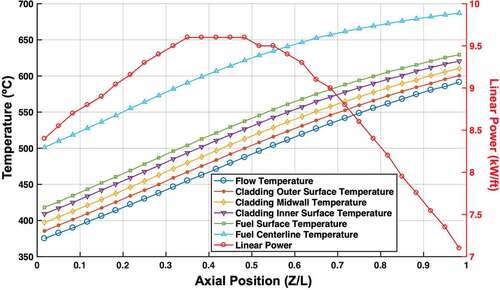
Fig. 8. Neutronic data: axial profiles of burnup, power density, fast and total neutron fluence, and cycle DPA of pin DP09 (X447 subassembly) in run 149A.
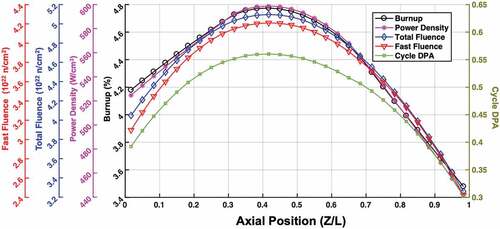
Fig. 9. Distribution of fuel peak operating conditions (peak fuel center temperature versus peak burnup) for all pins in the FIPD.
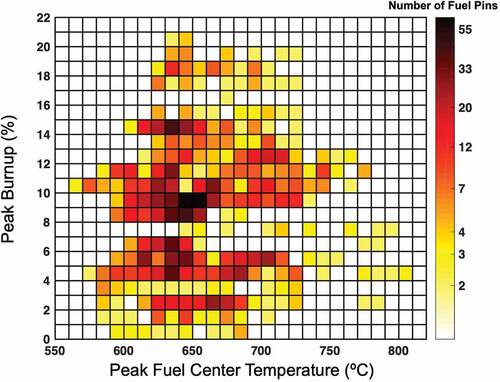
shows the plot of peak DPA versus peak cladding mid-wall temperature for all fuel pins (including SS316, D9, and HT9) in the FIPD. The data cover a wide range of DPAs (from <5 to 120) and cladding temperatures (~450°C to ~650°C). Many fuel pins are located near the center region of , where the DPA is ~50 and the cladding temperatures range from ~500°C to 560°C. Note again that while the cladding experienced such conditions, the peak temperature location is different from the peak DPA location, as indicated in .
IV.D. PIE Data
In each irradiation experiment, a subset of the fuel pins was selected for various PIEs, including fission gas release and gas chemistry measurements, contact and laser profilometry measurements, gamma scans, and NRAD. Details of the available PIE data are shown in . The contact and laser profilometry measurements are nondestructive examinations of the cladding dimensional changes, indicating the extent of cladding dimensional changes due to different phenomena, including creep and void swelling, as well as fuel-cladding mechanical interaction behavior.Citation36 Isotopic gamma scan data record the concentrations of specific isotopes (e.g., CS134, CS137, MN54, NB95, and RH106) along a fuel pin. Irradiated length is the measurement of the length of the fuel slug after irradiation. NRAD data are used to determine fuel swelling in both the axial and radial directions. The complete list of PIE data can be found in CitationRef. 11. Associated with the digitized PIE data, the FIPD document library also contains collections of documents including PIE planning memorandums and relevant reports and publications. The PIE data qualifications are being performed systematically according to the ANL QAPP. The priority of performing the data qualification has been placed on contact and laser profilometry, which has been requested by various programs and users.Citation37–40 For each data set, a QA procedure developed by implementing the QAPP was followed to qualify the data. The procedure for qualifying the data following the peer review method was discussed in Sec. III.
TABLE II Summary of PIE Measurements of Pins Stored in the FIPD
V. STATUS OF DATA QUALIFICATION
represents the current state of PIE data availability in the FIPD database, and additional data and documents are being recovered and added to the database. For example, over 300 NRAD data sets were recovered and added to the FIPD in 2021 (CitationRef. 39). While QA activities have primarily focused on the existing records in the FIPD, the activities will eventually extend to cover these new data sets. Currently, the FIPD contains the irradiation data sets for ~1900 fuel pins, some of which include complete sets of PIE data, with the majority limited to profilometry and NRAD measurements. For these two types of measurements, the profilometry data of ~1000 fuel pins and the neutron radiography data of ~900 fuel pins are currently available in the FIPD, which cover the most important IFR experiments over a range of operating/irradiation conditions. Other types of PIEs are also available, as shown in . So far, the qualification process has been exercised on some of the contact and laser profilometry measurements, NRAD, irradiated fuel length and diameter measurements, and fission gas release data. The qualification effort continues, and qualification of a majority of the important experiments’ data will be completed soon, with priority set mainly by industry and DOE program needs.
The initial evaluation of the software quality status of the three neutron physics and thermofluid codes (REBUS, RCT, and SE2RCT) that form the basis of calculated quantities for as-irradiated characteristics of the tested metallic fuel elements have been performed recently.Citation26 In addition, an automated verification framework was proposed to simplify the software QA process. The purpose of this framework is to streamline code verification and documentation while minimizing repetitive tasks for code developers and reviewers. More details can be found in CitationRef. 26.
As mentioned previously, qualification of the large collection of data required prioritization of the effort. The first data qualification effort was related to Oklo Power’s metallic fuel–based fast spectrum microreactor and was focused on data for U-10Zr with SS316 cladding at low burnup. Relevant profilometry, fission gas release, fuel diameter measurements, and cladding density measurements were qualified as part of this effort.Citation40 More recently, there has been an ongoing effort to qualify specific data that were used in the validation efforts for the BISON code in support of the DOE NEAMS campaign. Other ongoing qualification efforts are supporting TerraPower‘s NATRIUM™ reactor design and licensing through a DOE industry Advanced Reactor Demonstration Program award.Citation5
VI. SUMMARY
In this paper, the process of qualifying legacy metallic fuel data generated during the IFR program is presented. To manage the data and associated documents, a QA program plan for the metallic fuel data was established using the ASME NQA-1 2008/2009 Addenda standard. After review by the NRC, the plan was determined to satisfy the QA requirements of Appendix B of 10 CFR Part 50. The QA of the software associated with the metallic data is guided by a separate SQAPP. By implementing both plans, the metallic fuel data, including the operating parameters and PIE data, are being qualified. The priority for qualification is primarily determined based on the needs of industry and other DOE programs.
Acknowledgments
The work submitted for this paper was supported by the DOE NE under the Advanced Reactor Technology portfolio’s Microreactor Program. The content represents ongoing efforts by the Microreactor Program to enable accelerated development and demonstration of microreactor technology. ANL’s work was supported by the DOE under contract number DE-AC02-06CH11357. The direction and support of the DOE NE is greatly appreciated.
This paper was created by UChicago Argonne, LLC, operator of ANL. The U.S. government retains for itself, and others acting on its behalf, a paid-up nonexclusive, irrevocable worldwide license in said paper to reproduce, prepare derivative works, distribute copies to the public, and perform publicly and display publicly, by or on behalf of the government. The DOE will provide public access to the results of federally sponsored research in accordance with the DOE Public Access Plan: http://energy.gov/downloads/doe-public-access-plan.
Disclosure Statement
No potential conflict of interest was reported by the authors.
References
- G. L. HOFMAN, L. C. WALTERS, and T. H. BAUER, “Metallic Fast Reactor Fuels,” Prog. Nucl. Energy, 204, 141 (1997).
- “Oklo Power Combined Operating License Application for the Aurora at INL-Part II: Final Safety Analysis Report,” ML20075A003, Oklo Power (2020).
- “Pilot Application for DG-1353,” Oklo-2018-RlO-P, Rev. 0, Oklo Inc. (2018).
- “Combined License Application Documents for Aurora—Oklo Power Plant Application,” U.S. Nuclear Regulatory Commission (2020); https://www.nrc.gov/reactors/new-reactors/col/aurora-oklo/documents.html ( current as of Oct. 5, 2021).
- NATRiUM; https://natriumpower.com ( current as of Oct. 5, 2021).
- J. SACKETT and E. D. ARTHUR, “The ARC-100 Advanced SMR,” presented at the Committee on the Merits and Viability of Different Nuclear Fuel Cycles and Technology Options and the Waste Aspects of Advanced Nuclear Reactors 2021 (2021).
- C. E. STEVENSON, The EBR-II Fuel Cycle Story, American Nuclear Society (1987).
- C. P. CABELL, “Summary Description of the Fast Flux Test Facility,” HEDL–400, Hanford Engineering Development Laboratory (1980).
- Y. I. CHANG, “The Integral Fast-Reactor,” Nucl. Technol., 88, 2, 129 (1989); https://doi.org/10.13182/NT88-129.
- C. E. TILL, Y. I. CHANG, and W. H. HANNUM, “The Integral Fast Reactor—An Overview,” Prog. Nucl. Energy, 31, 1, 3 (1997); https://doi.org/10.1016/0149-1970(96)00001-7.
- A. M. YACOUT et al., “FIPD: The SFR Metallic Fuels Irradiation & Physics Database,” Nucl. Eng. Des., 380, 111225 (2021); https://doi.org/10.1016/j.nucengdes.2021.111225.
- A. OAKS et al., “Development of FIPD: The EBR-II Fuels Irradiation & Physics Database,” presented at the GLOBAL 2019, September 22–26, 2019.
- “Addenda to ASME NQA-1–2008 Quality Assurance Requirements for Nuclear Facility Applications,” ASME NQA-1a–2009, American Society of Mechanical Engineers (2009).
- T. BENOIT, K. MO, and A. YACOUT, “Quality Assurance Program Plan for SFR Metallic Fuel Data Qualification,” ANL/NE-16-17 Rev 2, ML19311C506, Argonne National Laboratory (2019).
- “Regulatory Audit Report of Argonne National Laboratory for Providing Legacy Data in Support of Advanced Reactor Technology License Applications (CAC NO. A17017),” ML21209A984, U.S. Nuclear Regulatory Commission (2021).
- “Quality Assurance Requirements for Nuclear Facility Applications,” ASME NQA-1–2008, American Society of Mechanical Engineers (2008).
- A. M. YACOUT and M. C. BILLONE, “Pre-Licensing Evaluation of Legacy SFR Metallic Fuel Data,” Argonne National Laboratory, ANL-ART–76 (Sep. 16, 2016).
- R. D. MCNIGHT, “Validation of the REBUS-3/RCT Methodologies for EBR-II Core-Follow Analysis,” ANL-IFR-153, Argonne National Laboratory (1991).
- K. L. DERSTINE, “DIF3D: A Code to Solve One-, Two-, and Three-Dimensional Finite-Difference Diffusion Theory Problems,” ANL-82-64, Argonne National Laboratory (1984).
- G. PALMIOTTI, E. E. LEWIS, and C. B. CARRICO, “VARIANT: VARIational Anisotropic Nodal Transport for Multidimensional Cartesian and Hexagonal Geometry Calculation,” ANL–95/40, Argonne National Laboratory (1995).
- B. J. TOPPEL, “User’s Guide for the REBUS-3 Fuel Cycle Analysis Capability,” ANL-83-2, Argonne National Laboratory (1983).
- A. GOPALAKRISHNAN and J. L. GILLETTE, “EBRFLOW—A Computer Program for Predicting the Coolant Flow Distribution in the Experimental Breeder Reactor-II,” Nucl. Technol., 17, 3, 205 (1973); https://doi.org/10.13182/NT73-A31264.
- W. S. YANG and A. M. YACOUT, “Assessment of the SE2-ANL Code Using EBR-II Temperature Measurements,” presented at the 7th Int. Mtg. on Nuclear Reactor Thermal-Hydraulics, Saratoga Springs, New York (1995).
- K. L. BASEHORE and N. E. TODREAS, “SUPERENERGY-2: A Multiassembly, Steady-State Computer Code for LMFBR Core Thermal-Hydraulic Analysis,” PNL-3379, Pacific Northwest Laboratory (1980).
- A. YOUNG, J. WOODFORD, and A. YACOUT, “Software Quality Assurance Program Plan for Nuclear Fuel Codes and Data,” Argonne National Laboratory (2017).
- M. A. SMITH, L. IBARRA, and A. OAKS, “Software Quality Assurance for EBR-II Fuels Irradiation and Physics Database (FIPD),” ANL-ART-238, Argonne National Laboratory (2021).
- W. S. YANG, “RCT—A Code to Reconstruct Pin Power and Burnup Characteristics from Nodal Calculations in Hexagonal Geometry,” ANL-IFR-192, Argonne National Laboratory (1993).
- B. J. T. H. HENRYSON II and C. G. STENBERG, “MC2-2: A Code to Calculate Fast Neutron Spectra and Multigroup Cross Sections,” ANL–8144, Argonne National Laboratory (1976).
- D. L. PORTER, “X441 Profilometry,” Idaho National Laboratory, Personal Communication (2020).
- D. C. CRAWFORD, S. L. HAYES, and J. J. POWERS, “VTR Startup Fuel Paper for NFSM,” INL/EXT-18-44673, Idaho National Laboratory (2018).
- C. E. LAHM et al., “Experience with Advanced Driver Fuels in EBR-II,” J. Nucl. Mater., 204, 119 (1993); https://doi.org/10.1016/0022-3115(93)90207-F.
- D. C. CRAWFORD et al., “Performance of U-Pu-Zr Fuel Cast into Zirconium Molds,” J. Nucl. Mater., 204, 157 (1993); https://doi.org/10.1016/0022-3115(93)90212-H.
- H. TSAI and G. L. BATTE, “X489 Data Package,” Argonne National Laboratory, Unpublished Information (1990).
- T. SOFU, “Development of Safety, Irradiation, and Reliability Databases Based on Past U.S. SFR Testing and Operational Experiences,” presented at the Int. Conf. on Fast Reactors and Related Fuel Cycles: Next Generation Nuclear Systems for Sustainable Development (FR17), Yekaterinburg, Russia, International Atomic Energy Agency (2017).
- R. D. MCKNIGHT et al., “Validation and Application of a Physics Database for Fast Reactor Fuel Cycle Analysis,” presented at the American Nuclear Society 1994 Topl. Mtg. on Advances in Reactor Physics, Knoxville, Tennessee (1994).
- R. G. PAHL et al., “Experimental Studies of U-Pu-Zr Fast-Reactor Fuel-Pins in the Experimental Breeder Reactor-II,” Metall. Trans. A, 21, 7, 1863 (1990); https://doi.org/10.1007/BF02647233.
- K. M. PAAREN et al., “Cladding Profilometry Analysis of Experimental Breeder Reactor-II Metallic Fuel Pins with HT9, D9, and SS316 Cladding,” Energies, 14, 2, 515 (2021); https://doi.org/10.3390/en14020515.
- K. M. PAAREN et al., “Initial Demonstration of Automated Fuel Performance Modeling with 1977 EBR-II Metallic Fuel Pins Using BISON Code with FIPD and IMIS Databases,” Nucl. Eng. Des., 382, 111393 (2021); https://doi.org/10.1016/j.nucengdes.2021.111393.
- A. OAKS et al., “FY20 Progress Report on FIPD Development and User Support,” ANL-ART-215, Argonne National Laboratory (2020).
- A. M. YACOUT, “Legacy Metal Fuel Data Exploration for Commercial Scale-Up,” ANL/CFCT-C16144, Argonne National Laboratory (2019).


